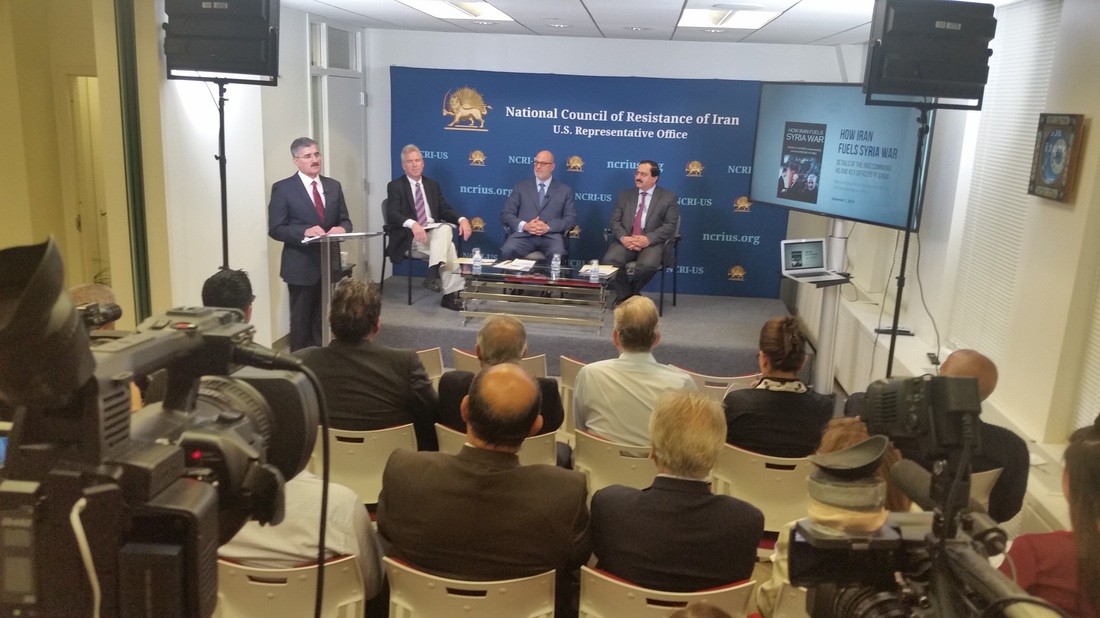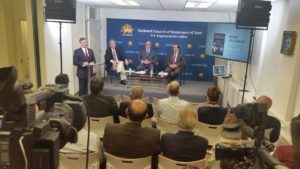

WASHINGTON, Sept. 2, 2016 /PRNewswire-USNewswire/ — In a panel discussion organized by the U.S. Representative Office of the National Council of Resistance of Iran (NCRI-US), former U.S. Ambassador to Bahrain and State Department Spokesman Adam Ereli, Vice President Al Gore’s Communication Director and senior fellow at the American Foreign Policy Council Larry Haas, and NCRI-US Deputy Director Alireza Jafarzadeh, discussed the Iranian regime’s destructive role in the five-year-old Syrian Conflict. A new book, How Iran Fuels Syria War, was also made public.
The event, held at the NCRI’s Washington Office, was moderated by the Council’s Foreign Affairs Committee member Ali Safavi, who said “the startling picture, showing the heartbreaking silence of the five-year-old Syrian child, Omran Daqneesh, covered in dust from head to toe after being pulled from the rubble following an airstrike, mirrors the stunning silence of the West regarding the Syrian tragedy.”
In his remarks, Amb. Ereli said that the release of the book, How Iran Fuels Syria War, was important “not only because what it tells us about what’s going on in Syria, but because what it tells us more broadly about how the Iranian regime operates; it’s a taxonomy of influence.” Commenting on the extent of Tehran’s regional interference, he added that by spending a lot of money, Iran is “not just controlling territory on the ground, but it’s buying loyalty. And the people who they’re supporting and their children and their children’s children are going to be Iranian advocates for many generations to come.” He added, “Syria is just the latest example to… create client states.”
Offering a broad perspective on policy vis-à-vis the Tehran regime, Mr. Haas said, “Iranian involvement in Syria reflects its continued expansionist and hegemonic ambitions that start in the region and go beyond. If anything, the regime has grown more aggressive in the aftermath of this nuclear deal, not less.” He added, “This shows the fallacy of two basic U.S. positions of recent years. The first, the hope that a nuclear agreement with Iran would moderate that regime. And that is a hope that drove U.S. policy toward Iran right from the start, going back to the reluctance to comment on the fraudulent election in 2009, reluctance to get behind the opposition… Second, Syria shows the fallacy of the U.S. belief that a reduced U.S. role in the region and beyond would lead to a safer world.”
In his remarks, Jafarzadeh pointed to the critical role the regime in Tehran has been playing to keep Bashar al-Assad in power, disclosing that the Syrian dictator had been intent on leaving the country after suffering setbacks in September 2015, but was dissuaded at the last minute by the Supreme Leader Ali Khamenei, as Assad arrived at the Glass Building located in Damascus Airport to depart the country.
NCRI Deputy Director revealed that Tehran had divided Syria into five military zones, and has established 18 military command centers across the country by the Islamic Revolutionary Guards Corps’ (IRGC) Qods Force. Iran’s military presence has increased to 70,000 IRGC, regular army forces, Iraqi, Afghan and Pakistani mercenaries as well as the Lebanese Hezbollah, Jafarzadeh emphasized, adding, “The fall of Assad would pave the way for the fall of the clerics ruling Iran; this explains Tehran’s huge financial and human resources spending in Syria.” He stressed that the international community must “end the Iranian regime’s occupation of Syria, exclude Tehran from international talks on Syria, not partner with the regime to fight ISIS, provide political and financial backing to Syria’s moderate opposition and establish a no-fly zone to protect the civilians.”

